Financial Analysis of Accounting Data: A Managerial Report
VerifiedAdded on 2019/11/14
|15
|3148
|167
Report
AI Summary
This report provides a comprehensive analysis of financial ratios, ethical dilemmas, and accounting systems within a managerial context. It begins with a calculation and interpretation of profitability ratios such as return on equity, return on assets, gross profit margin, net profit margin, and return on sales across three financial years. The analysis highlights trends and correlations among these ratios. The report then delves into an ethical case study involving overvaluation of assets and manipulation of financial records, discussing the stakeholders, the problem, and potential courses of action, evaluating each based on accounting standards and ethical principles. Finally, the report recommends the implementation of an integrated accounting system, detailing its benefits and assessing the implementation costs considering the current cash flow problems and inefficiencies of the business. The report emphasizes the system as a long-term investment and considers the implications of these recommendations on the company's financial health and operations.
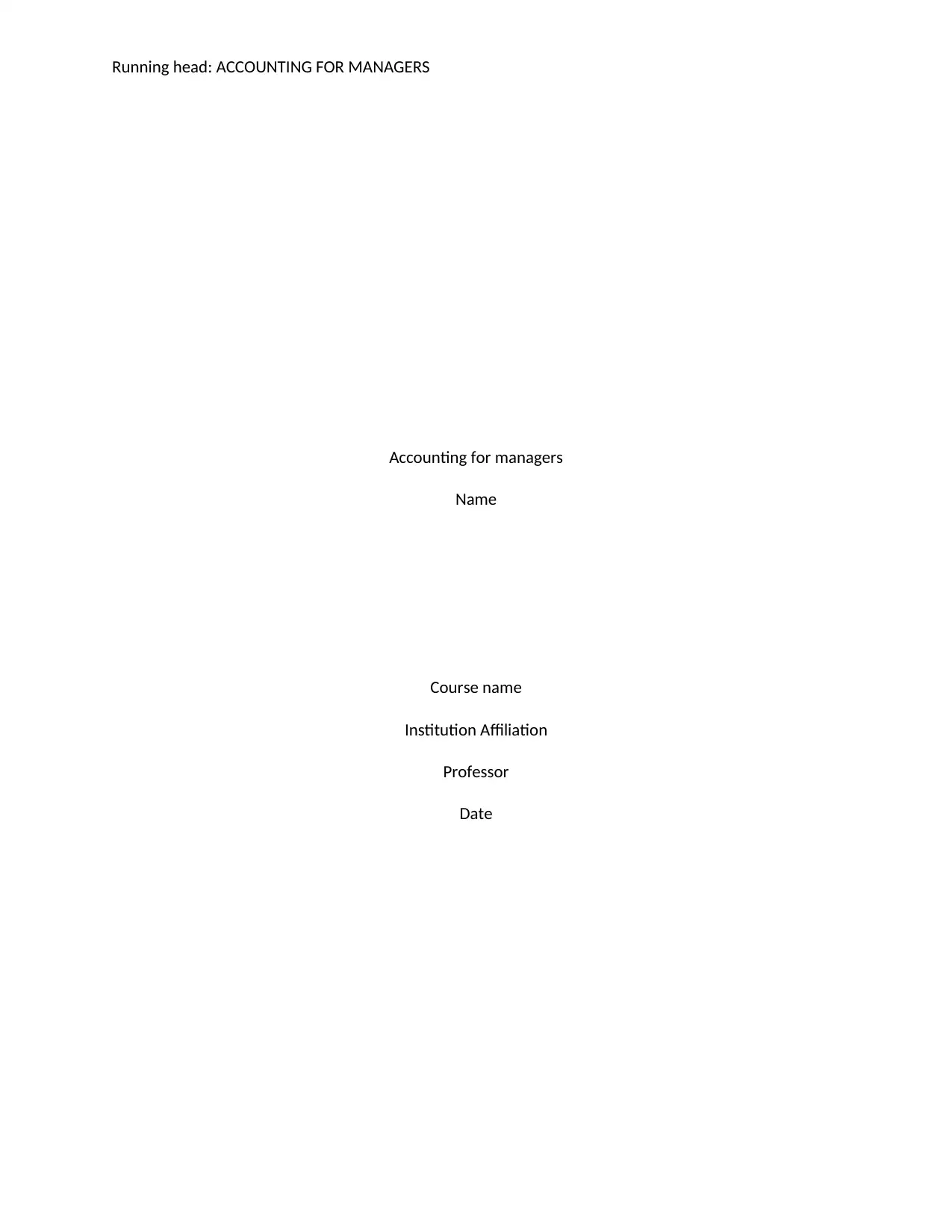
Running head: ACCOUNTING FOR MANAGERS
Accounting for managers
Name
Course name
Institution Affiliation
Professor
Date
Accounting for managers
Name
Course name
Institution Affiliation
Professor
Date
Paraphrase This Document
Need a fresh take? Get an instant paraphrase of this document with our AI Paraphraser
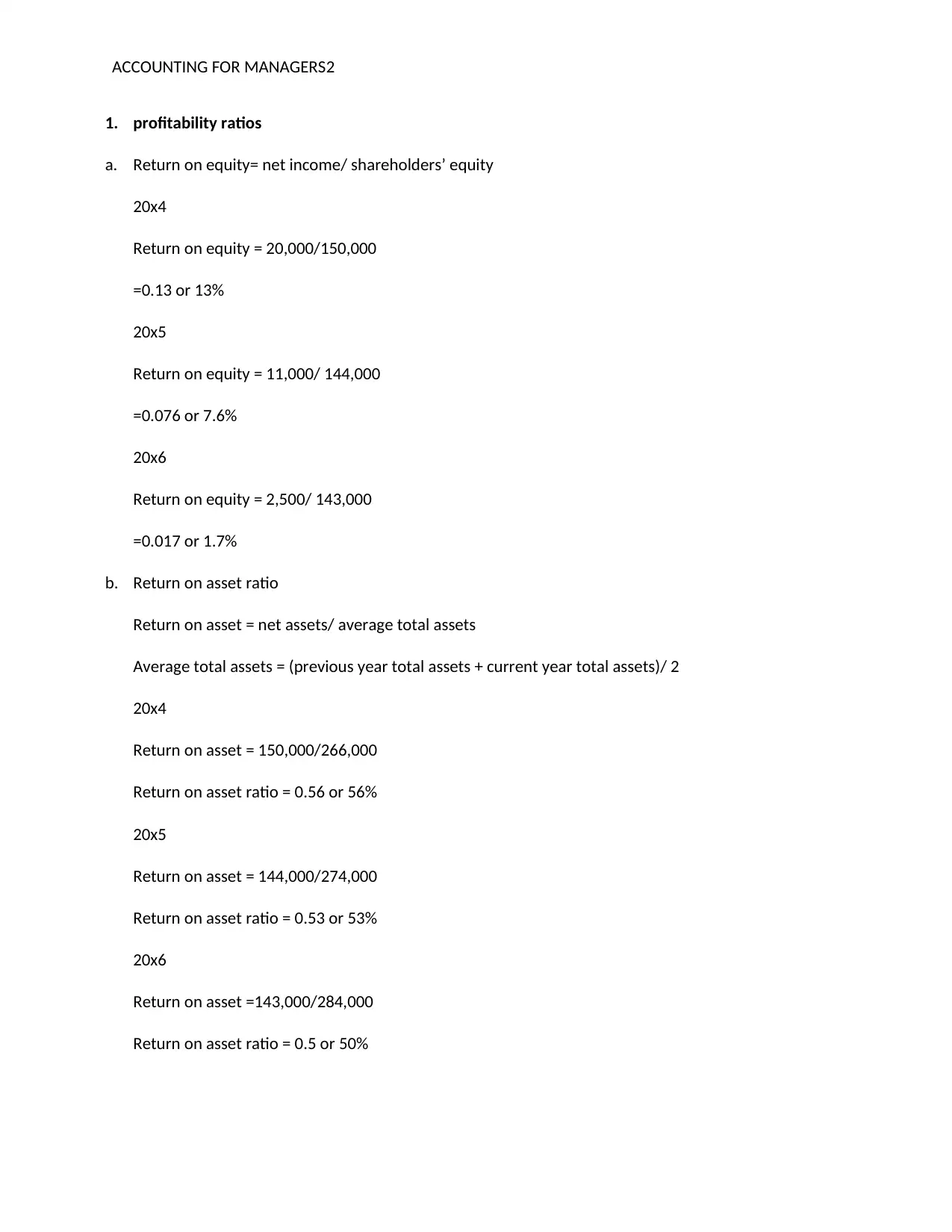
ACCOUNTING FOR MANAGERS2
1. profitability ratios
a. Return on equity= net income/ shareholders’ equity
20x4
Return on equity = 20,000/150,000
=0.13 or 13%
20x5
Return on equity = 11,000/ 144,000
=0.076 or 7.6%
20x6
Return on equity = 2,500/ 143,000
=0.017 or 1.7%
b. Return on asset ratio
Return on asset = net assets/ average total assets
Average total assets = (previous year total assets + current year total assets)/ 2
20x4
Return on asset = 150,000/266,000
Return on asset ratio = 0.56 or 56%
20x5
Return on asset = 144,000/274,000
Return on asset ratio = 0.53 or 53%
20x6
Return on asset =143,000/284,000
Return on asset ratio = 0.5 or 50%
1. profitability ratios
a. Return on equity= net income/ shareholders’ equity
20x4
Return on equity = 20,000/150,000
=0.13 or 13%
20x5
Return on equity = 11,000/ 144,000
=0.076 or 7.6%
20x6
Return on equity = 2,500/ 143,000
=0.017 or 1.7%
b. Return on asset ratio
Return on asset = net assets/ average total assets
Average total assets = (previous year total assets + current year total assets)/ 2
20x4
Return on asset = 150,000/266,000
Return on asset ratio = 0.56 or 56%
20x5
Return on asset = 144,000/274,000
Return on asset ratio = 0.53 or 53%
20x6
Return on asset =143,000/284,000
Return on asset ratio = 0.5 or 50%
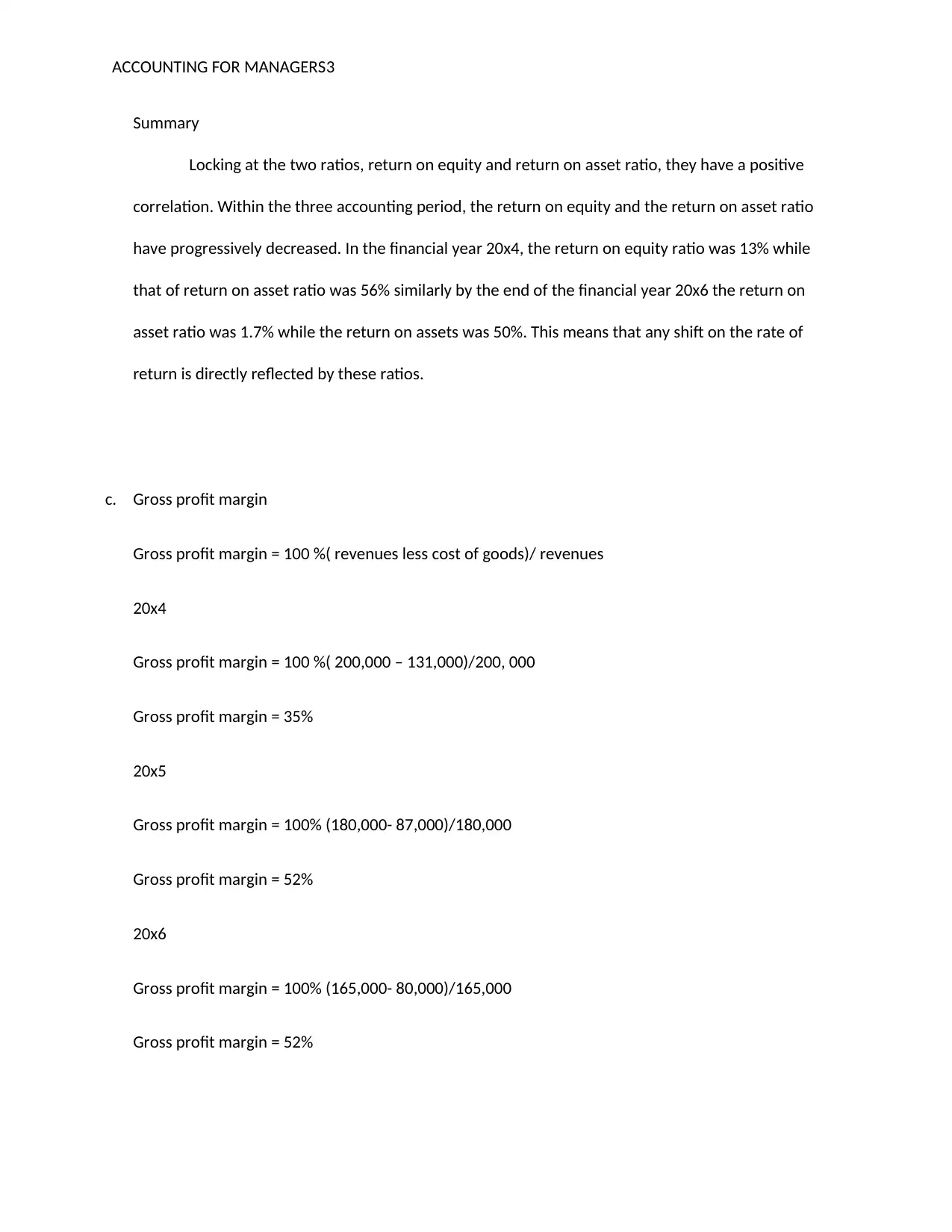
ACCOUNTING FOR MANAGERS3
Summary
Locking at the two ratios, return on equity and return on asset ratio, they have a positive
correlation. Within the three accounting period, the return on equity and the return on asset ratio
have progressively decreased. In the financial year 20x4, the return on equity ratio was 13% while
that of return on asset ratio was 56% similarly by the end of the financial year 20x6 the return on
asset ratio was 1.7% while the return on assets was 50%. This means that any shift on the rate of
return is directly reflected by these ratios.
c. Gross profit margin
Gross profit margin = 100 %( revenues less cost of goods)/ revenues
20x4
Gross profit margin = 100 %( 200,000 – 131,000)/200, 000
Gross profit margin = 35%
20x5
Gross profit margin = 100% (180,000- 87,000)/180,000
Gross profit margin = 52%
20x6
Gross profit margin = 100% (165,000- 80,000)/165,000
Gross profit margin = 52%
Summary
Locking at the two ratios, return on equity and return on asset ratio, they have a positive
correlation. Within the three accounting period, the return on equity and the return on asset ratio
have progressively decreased. In the financial year 20x4, the return on equity ratio was 13% while
that of return on asset ratio was 56% similarly by the end of the financial year 20x6 the return on
asset ratio was 1.7% while the return on assets was 50%. This means that any shift on the rate of
return is directly reflected by these ratios.
c. Gross profit margin
Gross profit margin = 100 %( revenues less cost of goods)/ revenues
20x4
Gross profit margin = 100 %( 200,000 – 131,000)/200, 000
Gross profit margin = 35%
20x5
Gross profit margin = 100% (180,000- 87,000)/180,000
Gross profit margin = 52%
20x6
Gross profit margin = 100% (165,000- 80,000)/165,000
Gross profit margin = 52%
You're viewing a preview
Unlock full access by subscribing today!
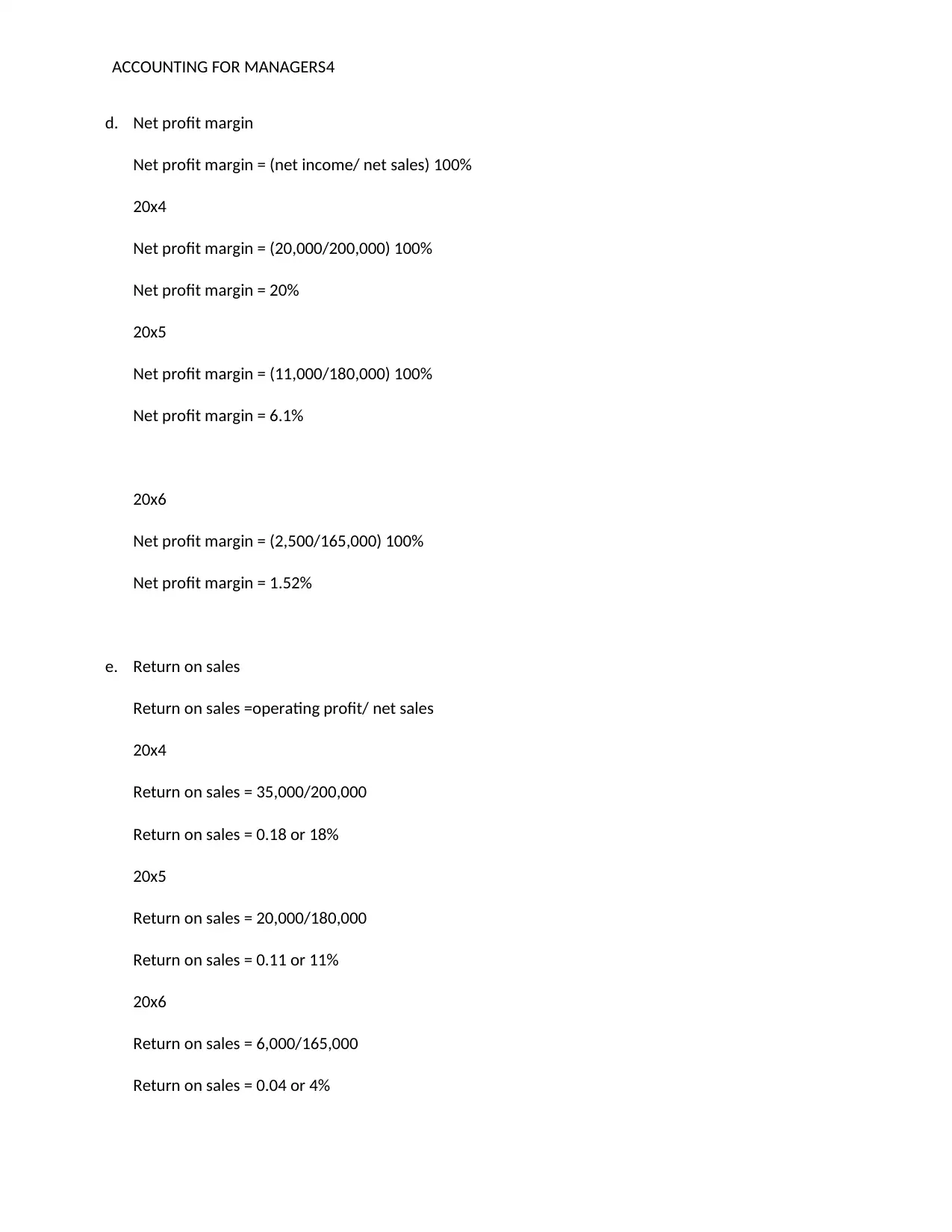
ACCOUNTING FOR MANAGERS4
d. Net profit margin
Net profit margin = (net income/ net sales) 100%
20x4
Net profit margin = (20,000/200,000) 100%
Net profit margin = 20%
20x5
Net profit margin = (11,000/180,000) 100%
Net profit margin = 6.1%
20x6
Net profit margin = (2,500/165,000) 100%
Net profit margin = 1.52%
e. Return on sales
Return on sales =operating profit/ net sales
20x4
Return on sales = 35,000/200,000
Return on sales = 0.18 or 18%
20x5
Return on sales = 20,000/180,000
Return on sales = 0.11 or 11%
20x6
Return on sales = 6,000/165,000
Return on sales = 0.04 or 4%
d. Net profit margin
Net profit margin = (net income/ net sales) 100%
20x4
Net profit margin = (20,000/200,000) 100%
Net profit margin = 20%
20x5
Net profit margin = (11,000/180,000) 100%
Net profit margin = 6.1%
20x6
Net profit margin = (2,500/165,000) 100%
Net profit margin = 1.52%
e. Return on sales
Return on sales =operating profit/ net sales
20x4
Return on sales = 35,000/200,000
Return on sales = 0.18 or 18%
20x5
Return on sales = 20,000/180,000
Return on sales = 0.11 or 11%
20x6
Return on sales = 6,000/165,000
Return on sales = 0.04 or 4%
Paraphrase This Document
Need a fresh take? Get an instant paraphrase of this document with our AI Paraphraser
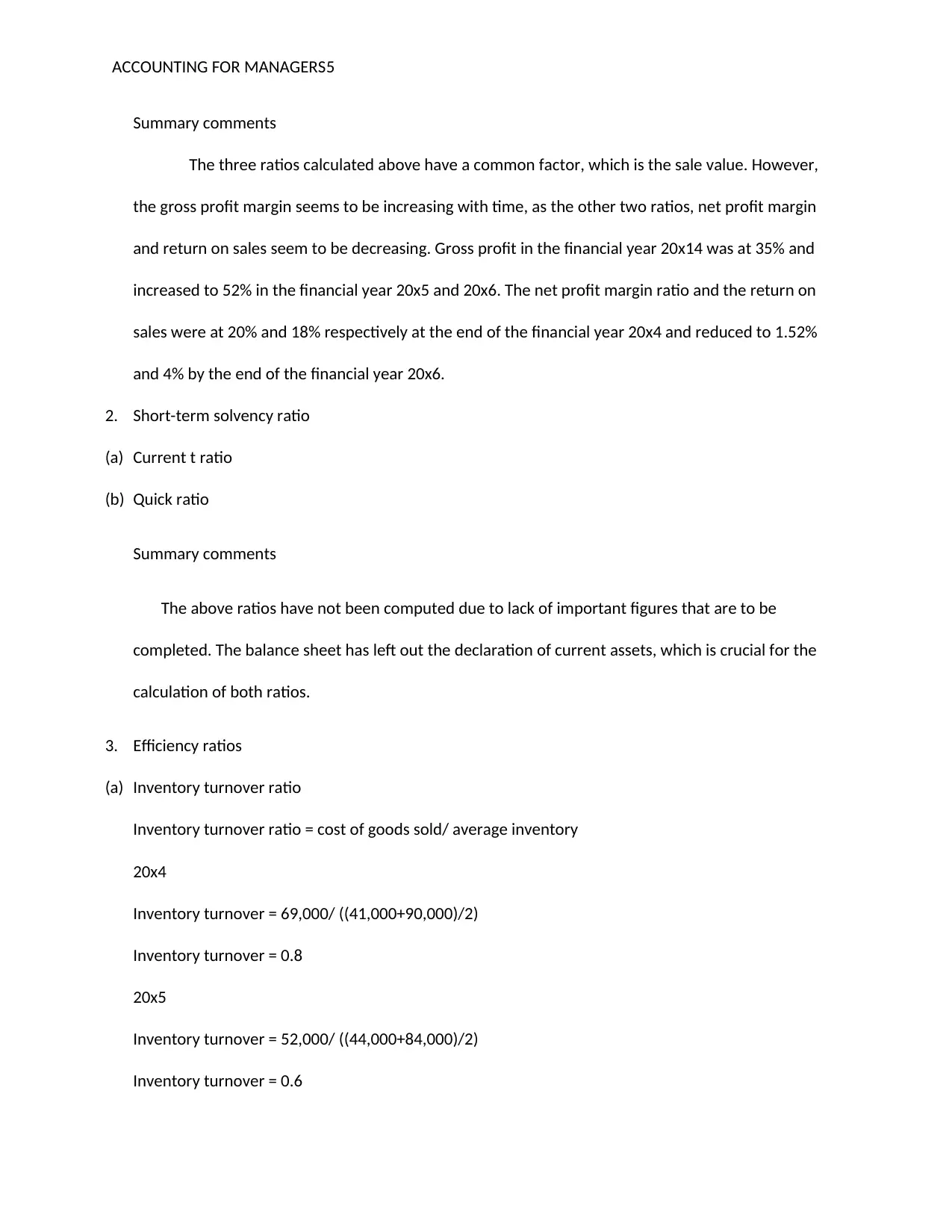
ACCOUNTING FOR MANAGERS5
Summary comments
The three ratios calculated above have a common factor, which is the sale value. However,
the gross profit margin seems to be increasing with time, as the other two ratios, net profit margin
and return on sales seem to be decreasing. Gross profit in the financial year 20x14 was at 35% and
increased to 52% in the financial year 20x5 and 20x6. The net profit margin ratio and the return on
sales were at 20% and 18% respectively at the end of the financial year 20x4 and reduced to 1.52%
and 4% by the end of the financial year 20x6.
2. Short-term solvency ratio
(a) Current t ratio
(b) Quick ratio
Summary comments
The above ratios have not been computed due to lack of important figures that are to be
completed. The balance sheet has left out the declaration of current assets, which is crucial for the
calculation of both ratios.
3. Efficiency ratios
(a) Inventory turnover ratio
Inventory turnover ratio = cost of goods sold/ average inventory
20x4
Inventory turnover = 69,000/ ((41,000+90,000)/2)
Inventory turnover = 0.8
20x5
Inventory turnover = 52,000/ ((44,000+84,000)/2)
Inventory turnover = 0.6
Summary comments
The three ratios calculated above have a common factor, which is the sale value. However,
the gross profit margin seems to be increasing with time, as the other two ratios, net profit margin
and return on sales seem to be decreasing. Gross profit in the financial year 20x14 was at 35% and
increased to 52% in the financial year 20x5 and 20x6. The net profit margin ratio and the return on
sales were at 20% and 18% respectively at the end of the financial year 20x4 and reduced to 1.52%
and 4% by the end of the financial year 20x6.
2. Short-term solvency ratio
(a) Current t ratio
(b) Quick ratio
Summary comments
The above ratios have not been computed due to lack of important figures that are to be
completed. The balance sheet has left out the declaration of current assets, which is crucial for the
calculation of both ratios.
3. Efficiency ratios
(a) Inventory turnover ratio
Inventory turnover ratio = cost of goods sold/ average inventory
20x4
Inventory turnover = 69,000/ ((41,000+90,000)/2)
Inventory turnover = 0.8
20x5
Inventory turnover = 52,000/ ((44,000+84,000)/2)
Inventory turnover = 0.6
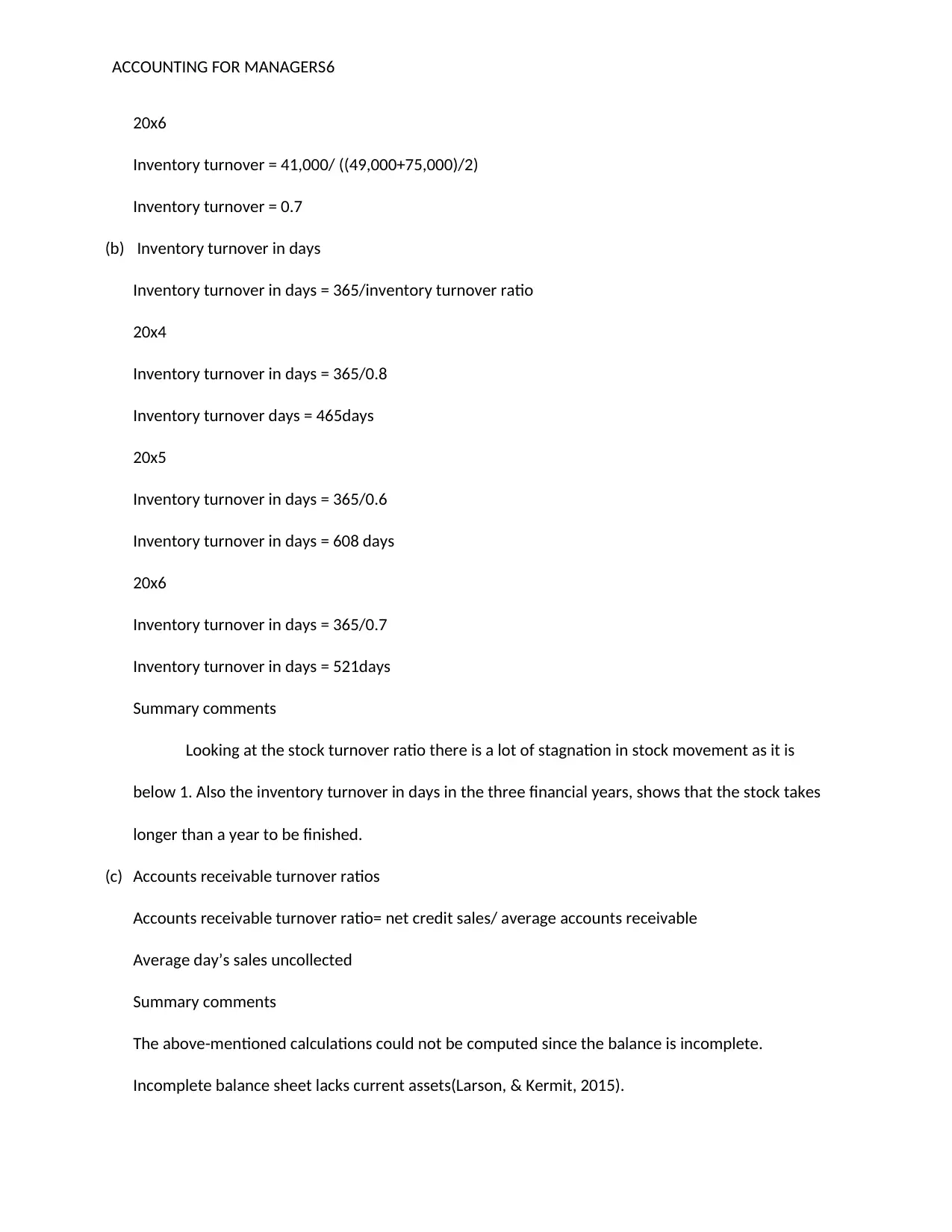
ACCOUNTING FOR MANAGERS6
20x6
Inventory turnover = 41,000/ ((49,000+75,000)/2)
Inventory turnover = 0.7
(b) Inventory turnover in days
Inventory turnover in days = 365/inventory turnover ratio
20x4
Inventory turnover in days = 365/0.8
Inventory turnover days = 465days
20x5
Inventory turnover in days = 365/0.6
Inventory turnover in days = 608 days
20x6
Inventory turnover in days = 365/0.7
Inventory turnover in days = 521days
Summary comments
Looking at the stock turnover ratio there is a lot of stagnation in stock movement as it is
below 1. Also the inventory turnover in days in the three financial years, shows that the stock takes
longer than a year to be finished.
(c) Accounts receivable turnover ratios
Accounts receivable turnover ratio= net credit sales/ average accounts receivable
Average day’s sales uncollected
Summary comments
The above-mentioned calculations could not be computed since the balance is incomplete.
Incomplete balance sheet lacks current assets(Larson, & Kermit, 2015).
20x6
Inventory turnover = 41,000/ ((49,000+75,000)/2)
Inventory turnover = 0.7
(b) Inventory turnover in days
Inventory turnover in days = 365/inventory turnover ratio
20x4
Inventory turnover in days = 365/0.8
Inventory turnover days = 465days
20x5
Inventory turnover in days = 365/0.6
Inventory turnover in days = 608 days
20x6
Inventory turnover in days = 365/0.7
Inventory turnover in days = 521days
Summary comments
Looking at the stock turnover ratio there is a lot of stagnation in stock movement as it is
below 1. Also the inventory turnover in days in the three financial years, shows that the stock takes
longer than a year to be finished.
(c) Accounts receivable turnover ratios
Accounts receivable turnover ratio= net credit sales/ average accounts receivable
Average day’s sales uncollected
Summary comments
The above-mentioned calculations could not be computed since the balance is incomplete.
Incomplete balance sheet lacks current assets(Larson, & Kermit, 2015).
You're viewing a preview
Unlock full access by subscribing today!
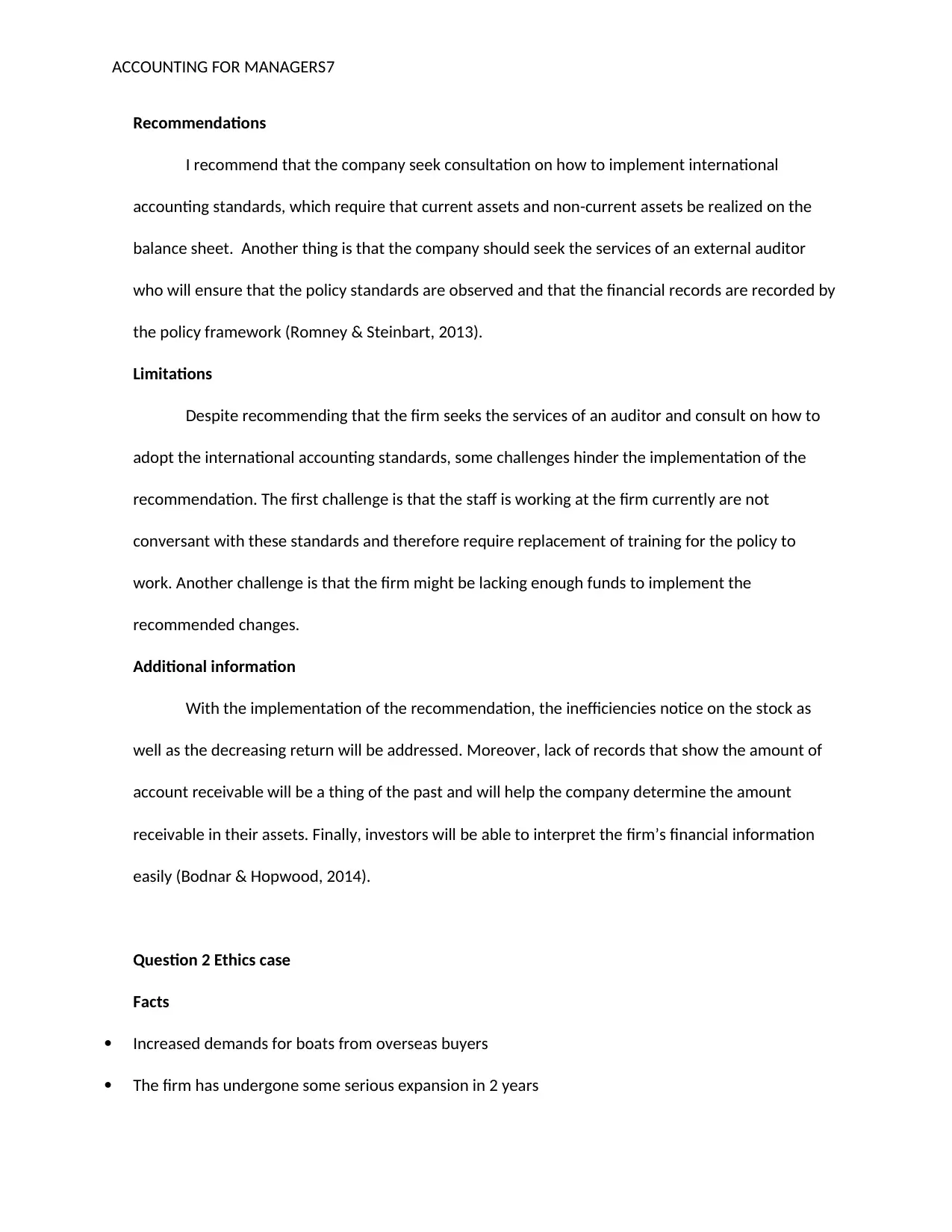
ACCOUNTING FOR MANAGERS7
Recommendations
I recommend that the company seek consultation on how to implement international
accounting standards, which require that current assets and non-current assets be realized on the
balance sheet. Another thing is that the company should seek the services of an external auditor
who will ensure that the policy standards are observed and that the financial records are recorded by
the policy framework (Romney & Steinbart, 2013).
Limitations
Despite recommending that the firm seeks the services of an auditor and consult on how to
adopt the international accounting standards, some challenges hinder the implementation of the
recommendation. The first challenge is that the staff is working at the firm currently are not
conversant with these standards and therefore require replacement of training for the policy to
work. Another challenge is that the firm might be lacking enough funds to implement the
recommended changes.
Additional information
With the implementation of the recommendation, the inefficiencies notice on the stock as
well as the decreasing return will be addressed. Moreover, lack of records that show the amount of
account receivable will be a thing of the past and will help the company determine the amount
receivable in their assets. Finally, investors will be able to interpret the firm’s financial information
easily (Bodnar & Hopwood, 2014).
Question 2 Ethics case
Facts
Increased demands for boats from overseas buyers
The firm has undergone some serious expansion in 2 years
Recommendations
I recommend that the company seek consultation on how to implement international
accounting standards, which require that current assets and non-current assets be realized on the
balance sheet. Another thing is that the company should seek the services of an external auditor
who will ensure that the policy standards are observed and that the financial records are recorded by
the policy framework (Romney & Steinbart, 2013).
Limitations
Despite recommending that the firm seeks the services of an auditor and consult on how to
adopt the international accounting standards, some challenges hinder the implementation of the
recommendation. The first challenge is that the staff is working at the firm currently are not
conversant with these standards and therefore require replacement of training for the policy to
work. Another challenge is that the firm might be lacking enough funds to implement the
recommended changes.
Additional information
With the implementation of the recommendation, the inefficiencies notice on the stock as
well as the decreasing return will be addressed. Moreover, lack of records that show the amount of
account receivable will be a thing of the past and will help the company determine the amount
receivable in their assets. Finally, investors will be able to interpret the firm’s financial information
easily (Bodnar & Hopwood, 2014).
Question 2 Ethics case
Facts
Increased demands for boats from overseas buyers
The firm has undergone some serious expansion in 2 years
Paraphrase This Document
Need a fresh take? Get an instant paraphrase of this document with our AI Paraphraser
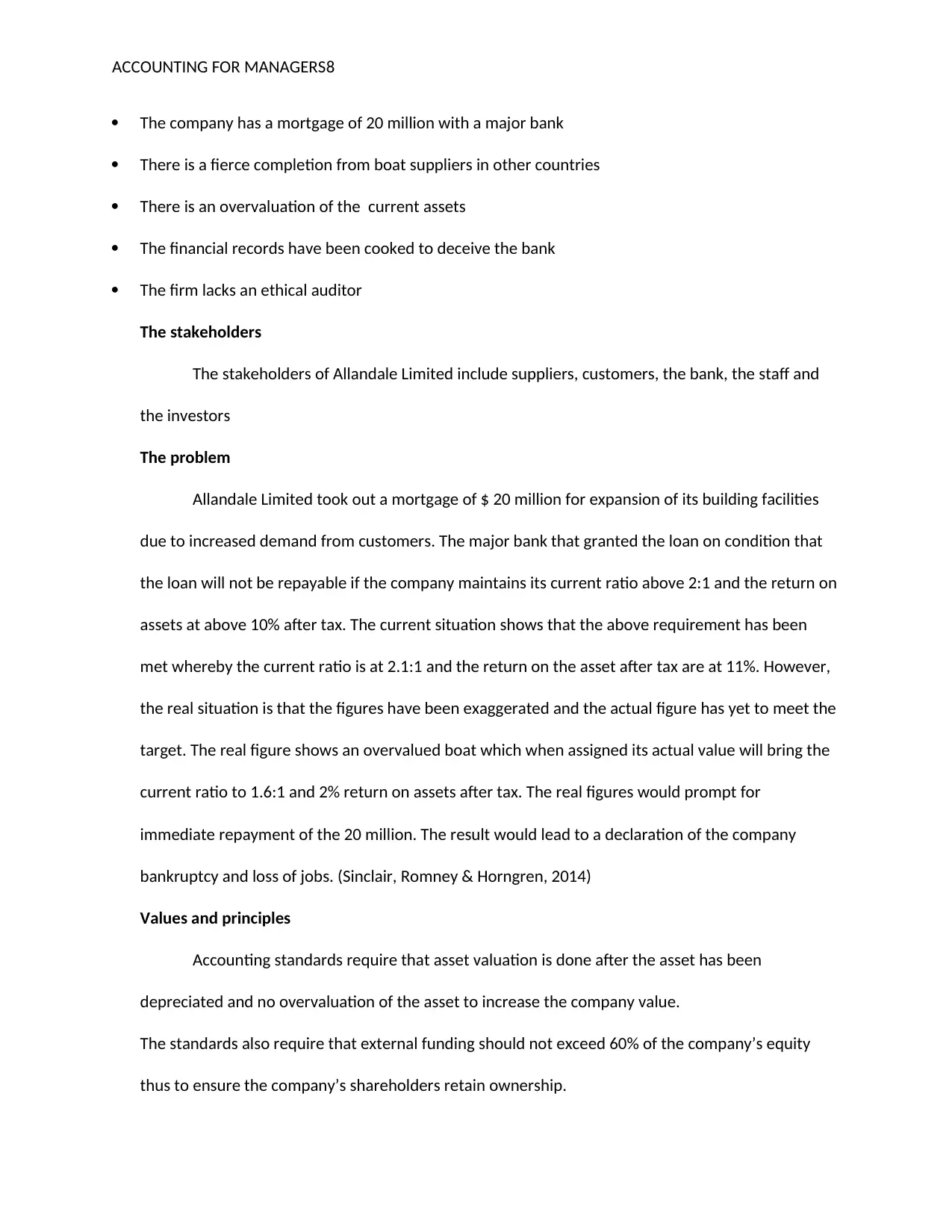
ACCOUNTING FOR MANAGERS8
The company has a mortgage of 20 million with a major bank
There is a fierce completion from boat suppliers in other countries
There is an overvaluation of the current assets
The financial records have been cooked to deceive the bank
The firm lacks an ethical auditor
The stakeholders
The stakeholders of Allandale Limited include suppliers, customers, the bank, the staff and
the investors
The problem
Allandale Limited took out a mortgage of $ 20 million for expansion of its building facilities
due to increased demand from customers. The major bank that granted the loan on condition that
the loan will not be repayable if the company maintains its current ratio above 2:1 and the return on
assets at above 10% after tax. The current situation shows that the above requirement has been
met whereby the current ratio is at 2.1:1 and the return on the asset after tax are at 11%. However,
the real situation is that the figures have been exaggerated and the actual figure has yet to meet the
target. The real figure shows an overvalued boat which when assigned its actual value will bring the
current ratio to 1.6:1 and 2% return on assets after tax. The real figures would prompt for
immediate repayment of the 20 million. The result would lead to a declaration of the company
bankruptcy and loss of jobs. (Sinclair, Romney & Horngren, 2014)
Values and principles
Accounting standards require that asset valuation is done after the asset has been
depreciated and no overvaluation of the asset to increase the company value.
The standards also require that external funding should not exceed 60% of the company’s equity
thus to ensure the company’s shareholders retain ownership.
The company has a mortgage of 20 million with a major bank
There is a fierce completion from boat suppliers in other countries
There is an overvaluation of the current assets
The financial records have been cooked to deceive the bank
The firm lacks an ethical auditor
The stakeholders
The stakeholders of Allandale Limited include suppliers, customers, the bank, the staff and
the investors
The problem
Allandale Limited took out a mortgage of $ 20 million for expansion of its building facilities
due to increased demand from customers. The major bank that granted the loan on condition that
the loan will not be repayable if the company maintains its current ratio above 2:1 and the return on
assets at above 10% after tax. The current situation shows that the above requirement has been
met whereby the current ratio is at 2.1:1 and the return on the asset after tax are at 11%. However,
the real situation is that the figures have been exaggerated and the actual figure has yet to meet the
target. The real figure shows an overvalued boat which when assigned its actual value will bring the
current ratio to 1.6:1 and 2% return on assets after tax. The real figures would prompt for
immediate repayment of the 20 million. The result would lead to a declaration of the company
bankruptcy and loss of jobs. (Sinclair, Romney & Horngren, 2014)
Values and principles
Accounting standards require that asset valuation is done after the asset has been
depreciated and no overvaluation of the asset to increase the company value.
The standards also require that external funding should not exceed 60% of the company’s equity
thus to ensure the company’s shareholders retain ownership.
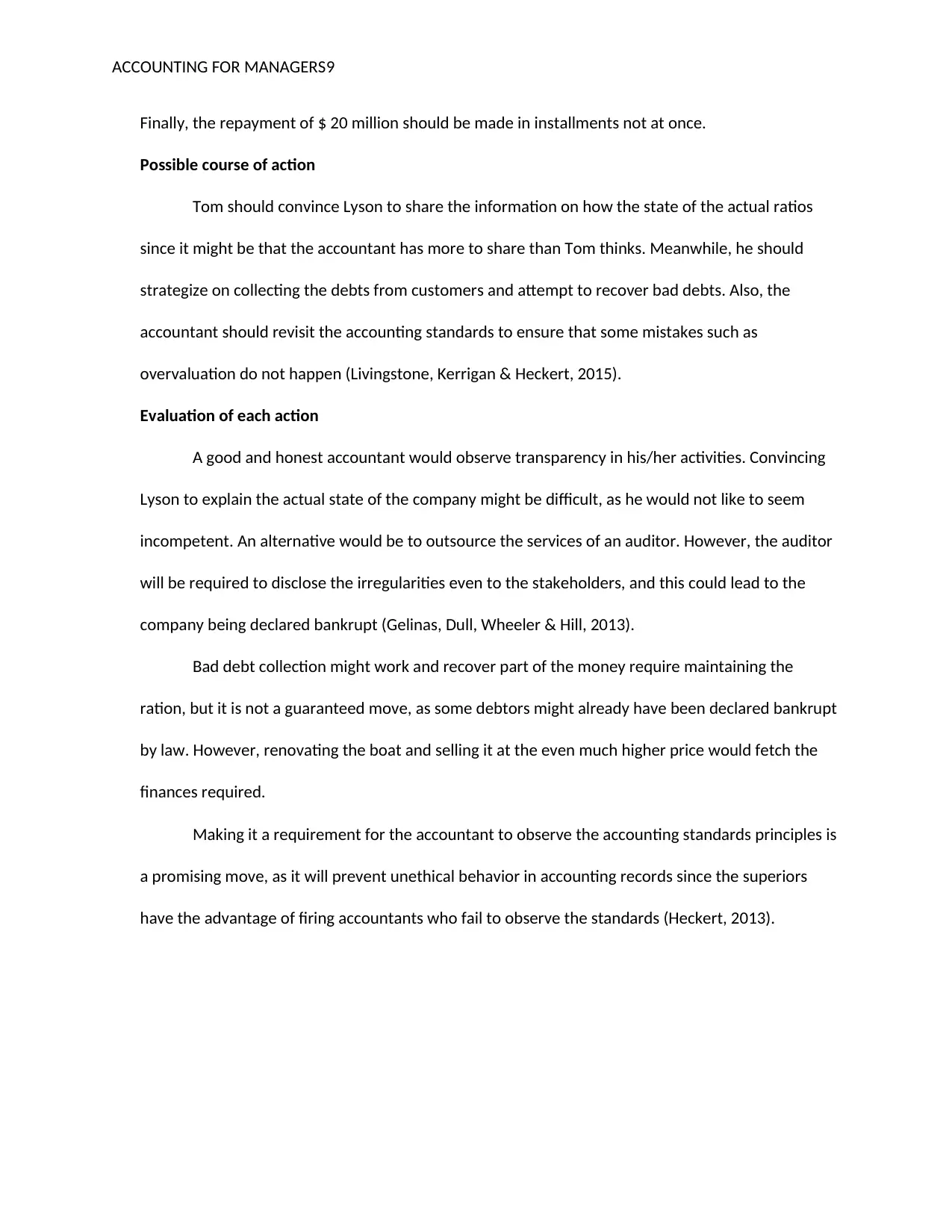
ACCOUNTING FOR MANAGERS9
Finally, the repayment of $ 20 million should be made in installments not at once.
Possible course of action
Tom should convince Lyson to share the information on how the state of the actual ratios
since it might be that the accountant has more to share than Tom thinks. Meanwhile, he should
strategize on collecting the debts from customers and attempt to recover bad debts. Also, the
accountant should revisit the accounting standards to ensure that some mistakes such as
overvaluation do not happen (Livingstone, Kerrigan & Heckert, 2015).
Evaluation of each action
A good and honest accountant would observe transparency in his/her activities. Convincing
Lyson to explain the actual state of the company might be difficult, as he would not like to seem
incompetent. An alternative would be to outsource the services of an auditor. However, the auditor
will be required to disclose the irregularities even to the stakeholders, and this could lead to the
company being declared bankrupt (Gelinas, Dull, Wheeler & Hill, 2013).
Bad debt collection might work and recover part of the money require maintaining the
ration, but it is not a guaranteed move, as some debtors might already have been declared bankrupt
by law. However, renovating the boat and selling it at the even much higher price would fetch the
finances required.
Making it a requirement for the accountant to observe the accounting standards principles is
a promising move, as it will prevent unethical behavior in accounting records since the superiors
have the advantage of firing accountants who fail to observe the standards (Heckert, 2013).
Finally, the repayment of $ 20 million should be made in installments not at once.
Possible course of action
Tom should convince Lyson to share the information on how the state of the actual ratios
since it might be that the accountant has more to share than Tom thinks. Meanwhile, he should
strategize on collecting the debts from customers and attempt to recover bad debts. Also, the
accountant should revisit the accounting standards to ensure that some mistakes such as
overvaluation do not happen (Livingstone, Kerrigan & Heckert, 2015).
Evaluation of each action
A good and honest accountant would observe transparency in his/her activities. Convincing
Lyson to explain the actual state of the company might be difficult, as he would not like to seem
incompetent. An alternative would be to outsource the services of an auditor. However, the auditor
will be required to disclose the irregularities even to the stakeholders, and this could lead to the
company being declared bankrupt (Gelinas, Dull, Wheeler & Hill, 2013).
Bad debt collection might work and recover part of the money require maintaining the
ration, but it is not a guaranteed move, as some debtors might already have been declared bankrupt
by law. However, renovating the boat and selling it at the even much higher price would fetch the
finances required.
Making it a requirement for the accountant to observe the accounting standards principles is
a promising move, as it will prevent unethical behavior in accounting records since the superiors
have the advantage of firing accountants who fail to observe the standards (Heckert, 2013).
You're viewing a preview
Unlock full access by subscribing today!
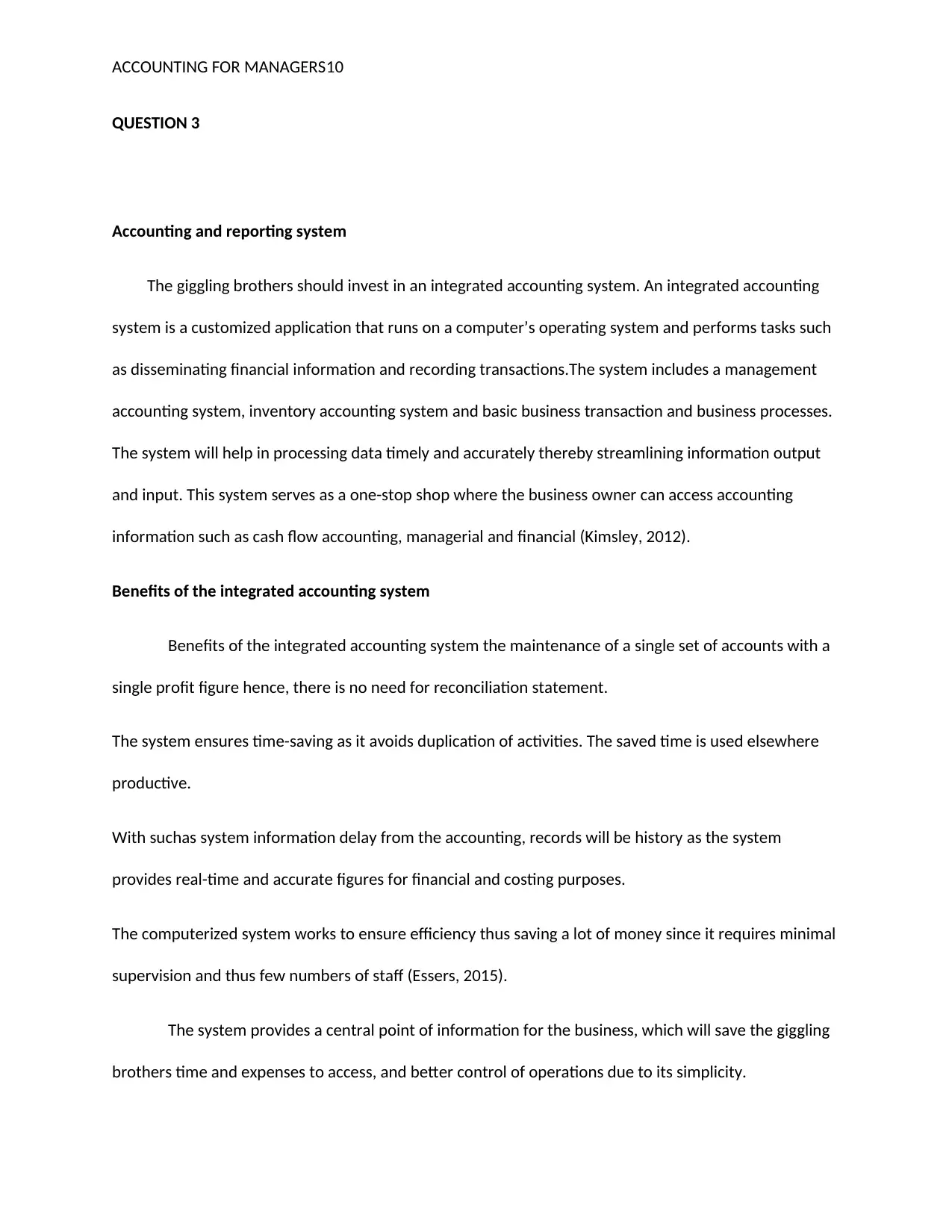
ACCOUNTING FOR MANAGERS10
QUESTION 3
Accounting and reporting system
The giggling brothers should invest in an integrated accounting system. An integrated accounting
system is a customized application that runs on a computer’s operating system and performs tasks such
as disseminating financial information and recording transactions.The system includes a management
accounting system, inventory accounting system and basic business transaction and business processes.
The system will help in processing data timely and accurately thereby streamlining information output
and input. This system serves as a one-stop shop where the business owner can access accounting
information such as cash flow accounting, managerial and financial (Kimsley, 2012).
Benefits of the integrated accounting system
Benefits of the integrated accounting system the maintenance of a single set of accounts with a
single profit figure hence, there is no need for reconciliation statement.
The system ensures time-saving as it avoids duplication of activities. The saved time is used elsewhere
productive.
With suchas system information delay from the accounting, records will be history as the system
provides real-time and accurate figures for financial and costing purposes.
The computerized system works to ensure efficiency thus saving a lot of money since it requires minimal
supervision and thus few numbers of staff (Essers, 2015).
The system provides a central point of information for the business, which will save the giggling
brothers time and expenses to access, and better control of operations due to its simplicity.
QUESTION 3
Accounting and reporting system
The giggling brothers should invest in an integrated accounting system. An integrated accounting
system is a customized application that runs on a computer’s operating system and performs tasks such
as disseminating financial information and recording transactions.The system includes a management
accounting system, inventory accounting system and basic business transaction and business processes.
The system will help in processing data timely and accurately thereby streamlining information output
and input. This system serves as a one-stop shop where the business owner can access accounting
information such as cash flow accounting, managerial and financial (Kimsley, 2012).
Benefits of the integrated accounting system
Benefits of the integrated accounting system the maintenance of a single set of accounts with a
single profit figure hence, there is no need for reconciliation statement.
The system ensures time-saving as it avoids duplication of activities. The saved time is used elsewhere
productive.
With suchas system information delay from the accounting, records will be history as the system
provides real-time and accurate figures for financial and costing purposes.
The computerized system works to ensure efficiency thus saving a lot of money since it requires minimal
supervision and thus few numbers of staff (Essers, 2015).
The system provides a central point of information for the business, which will save the giggling
brothers time and expenses to access, and better control of operations due to its simplicity.
Paraphrase This Document
Need a fresh take? Get an instant paraphrase of this document with our AI Paraphraser
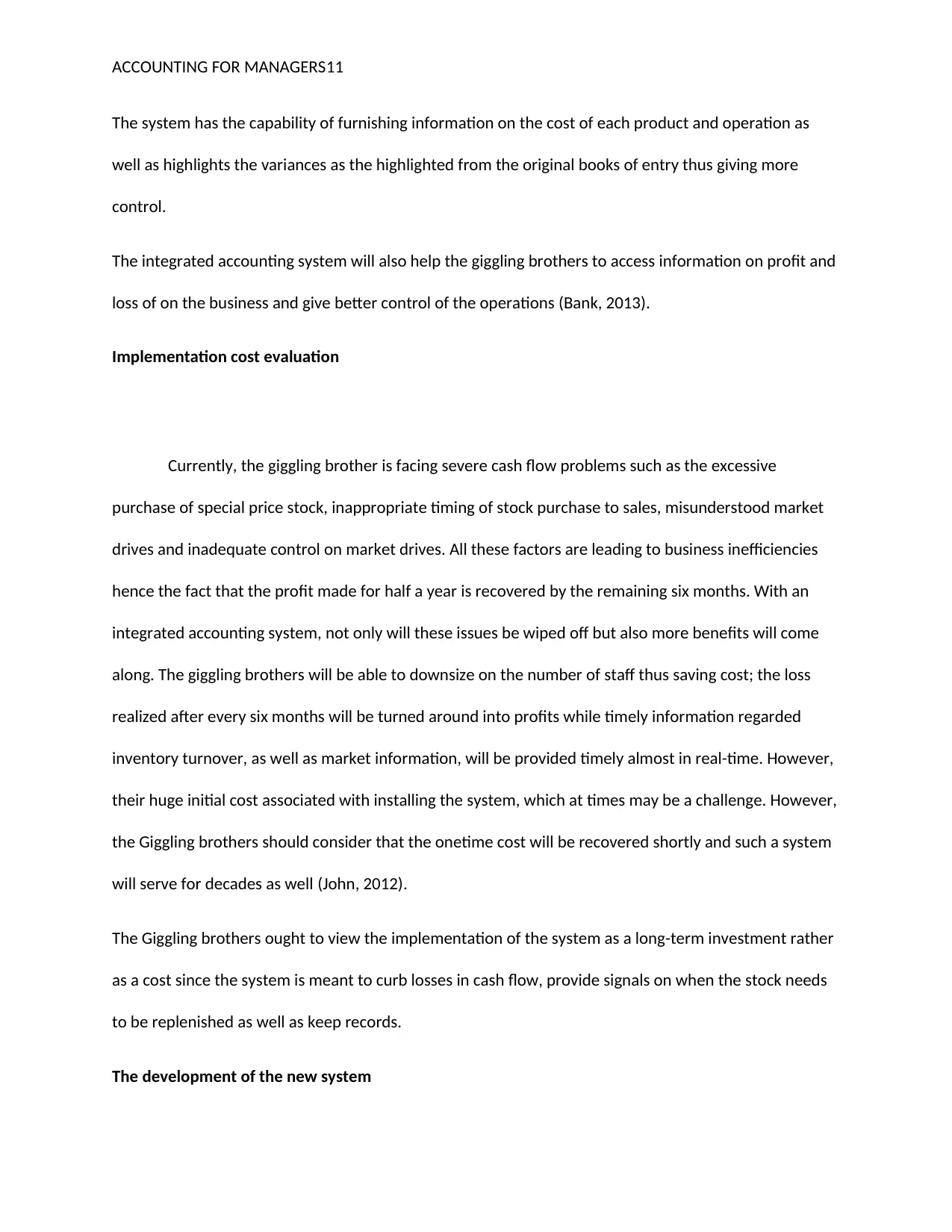
ACCOUNTING FOR MANAGERS11
The system has the capability of furnishing information on the cost of each product and operation as
well as highlights the variances as the highlighted from the original books of entry thus giving more
control.
The integrated accounting system will also help the giggling brothers to access information on profit and
loss of on the business and give better control of the operations (Bank, 2013).
Implementation cost evaluation
Currently, the giggling brother is facing severe cash flow problems such as the excessive
purchase of special price stock, inappropriate timing of stock purchase to sales, misunderstood market
drives and inadequate control on market drives. All these factors are leading to business inefficiencies
hence the fact that the profit made for half a year is recovered by the remaining six months. With an
integrated accounting system, not only will these issues be wiped off but also more benefits will come
along. The giggling brothers will be able to downsize on the number of staff thus saving cost; the loss
realized after every six months will be turned around into profits while timely information regarded
inventory turnover, as well as market information, will be provided timely almost in real-time. However,
their huge initial cost associated with installing the system, which at times may be a challenge. However,
the Giggling brothers should consider that the onetime cost will be recovered shortly and such a system
will serve for decades as well (John, 2012).
The Giggling brothers ought to view the implementation of the system as a long-term investment rather
as a cost since the system is meant to curb losses in cash flow, provide signals on when the stock needs
to be replenished as well as keep records.
The development of the new system
The system has the capability of furnishing information on the cost of each product and operation as
well as highlights the variances as the highlighted from the original books of entry thus giving more
control.
The integrated accounting system will also help the giggling brothers to access information on profit and
loss of on the business and give better control of the operations (Bank, 2013).
Implementation cost evaluation
Currently, the giggling brother is facing severe cash flow problems such as the excessive
purchase of special price stock, inappropriate timing of stock purchase to sales, misunderstood market
drives and inadequate control on market drives. All these factors are leading to business inefficiencies
hence the fact that the profit made for half a year is recovered by the remaining six months. With an
integrated accounting system, not only will these issues be wiped off but also more benefits will come
along. The giggling brothers will be able to downsize on the number of staff thus saving cost; the loss
realized after every six months will be turned around into profits while timely information regarded
inventory turnover, as well as market information, will be provided timely almost in real-time. However,
their huge initial cost associated with installing the system, which at times may be a challenge. However,
the Giggling brothers should consider that the onetime cost will be recovered shortly and such a system
will serve for decades as well (John, 2012).
The Giggling brothers ought to view the implementation of the system as a long-term investment rather
as a cost since the system is meant to curb losses in cash flow, provide signals on when the stock needs
to be replenished as well as keep records.
The development of the new system
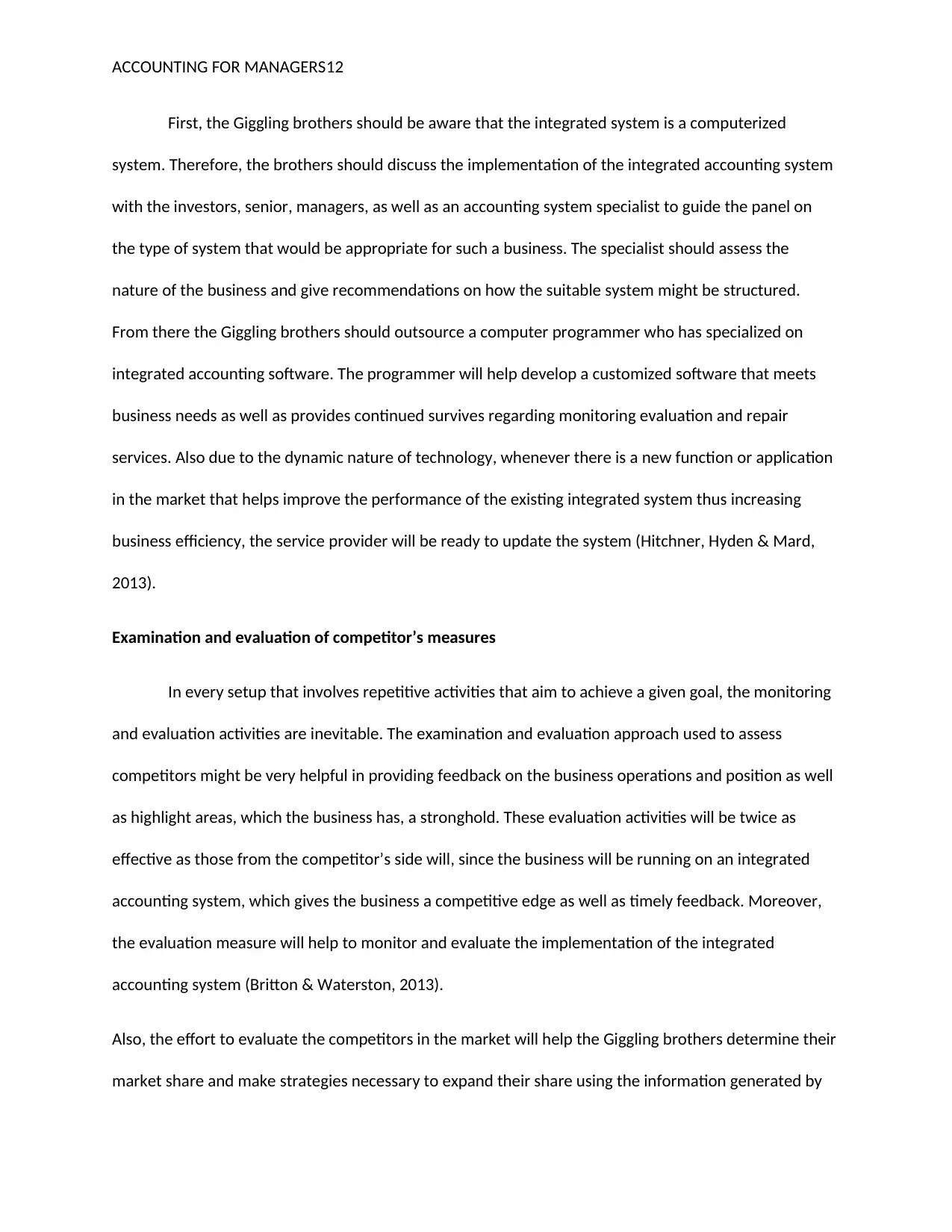
ACCOUNTING FOR MANAGERS12
First, the Giggling brothers should be aware that the integrated system is a computerized
system. Therefore, the brothers should discuss the implementation of the integrated accounting system
with the investors, senior, managers, as well as an accounting system specialist to guide the panel on
the type of system that would be appropriate for such a business. The specialist should assess the
nature of the business and give recommendations on how the suitable system might be structured.
From there the Giggling brothers should outsource a computer programmer who has specialized on
integrated accounting software. The programmer will help develop a customized software that meets
business needs as well as provides continued survives regarding monitoring evaluation and repair
services. Also due to the dynamic nature of technology, whenever there is a new function or application
in the market that helps improve the performance of the existing integrated system thus increasing
business efficiency, the service provider will be ready to update the system (Hitchner, Hyden & Mard,
2013).
Examination and evaluation of competitor’s measures
In every setup that involves repetitive activities that aim to achieve a given goal, the monitoring
and evaluation activities are inevitable. The examination and evaluation approach used to assess
competitors might be very helpful in providing feedback on the business operations and position as well
as highlight areas, which the business has, a stronghold. These evaluation activities will be twice as
effective as those from the competitor’s side will, since the business will be running on an integrated
accounting system, which gives the business a competitive edge as well as timely feedback. Moreover,
the evaluation measure will help to monitor and evaluate the implementation of the integrated
accounting system (Britton & Waterston, 2013).
Also, the effort to evaluate the competitors in the market will help the Giggling brothers determine their
market share and make strategies necessary to expand their share using the information generated by
First, the Giggling brothers should be aware that the integrated system is a computerized
system. Therefore, the brothers should discuss the implementation of the integrated accounting system
with the investors, senior, managers, as well as an accounting system specialist to guide the panel on
the type of system that would be appropriate for such a business. The specialist should assess the
nature of the business and give recommendations on how the suitable system might be structured.
From there the Giggling brothers should outsource a computer programmer who has specialized on
integrated accounting software. The programmer will help develop a customized software that meets
business needs as well as provides continued survives regarding monitoring evaluation and repair
services. Also due to the dynamic nature of technology, whenever there is a new function or application
in the market that helps improve the performance of the existing integrated system thus increasing
business efficiency, the service provider will be ready to update the system (Hitchner, Hyden & Mard,
2013).
Examination and evaluation of competitor’s measures
In every setup that involves repetitive activities that aim to achieve a given goal, the monitoring
and evaluation activities are inevitable. The examination and evaluation approach used to assess
competitors might be very helpful in providing feedback on the business operations and position as well
as highlight areas, which the business has, a stronghold. These evaluation activities will be twice as
effective as those from the competitor’s side will, since the business will be running on an integrated
accounting system, which gives the business a competitive edge as well as timely feedback. Moreover,
the evaluation measure will help to monitor and evaluate the implementation of the integrated
accounting system (Britton & Waterston, 2013).
Also, the effort to evaluate the competitors in the market will help the Giggling brothers determine their
market share and make strategies necessary to expand their share using the information generated by
You're viewing a preview
Unlock full access by subscribing today!
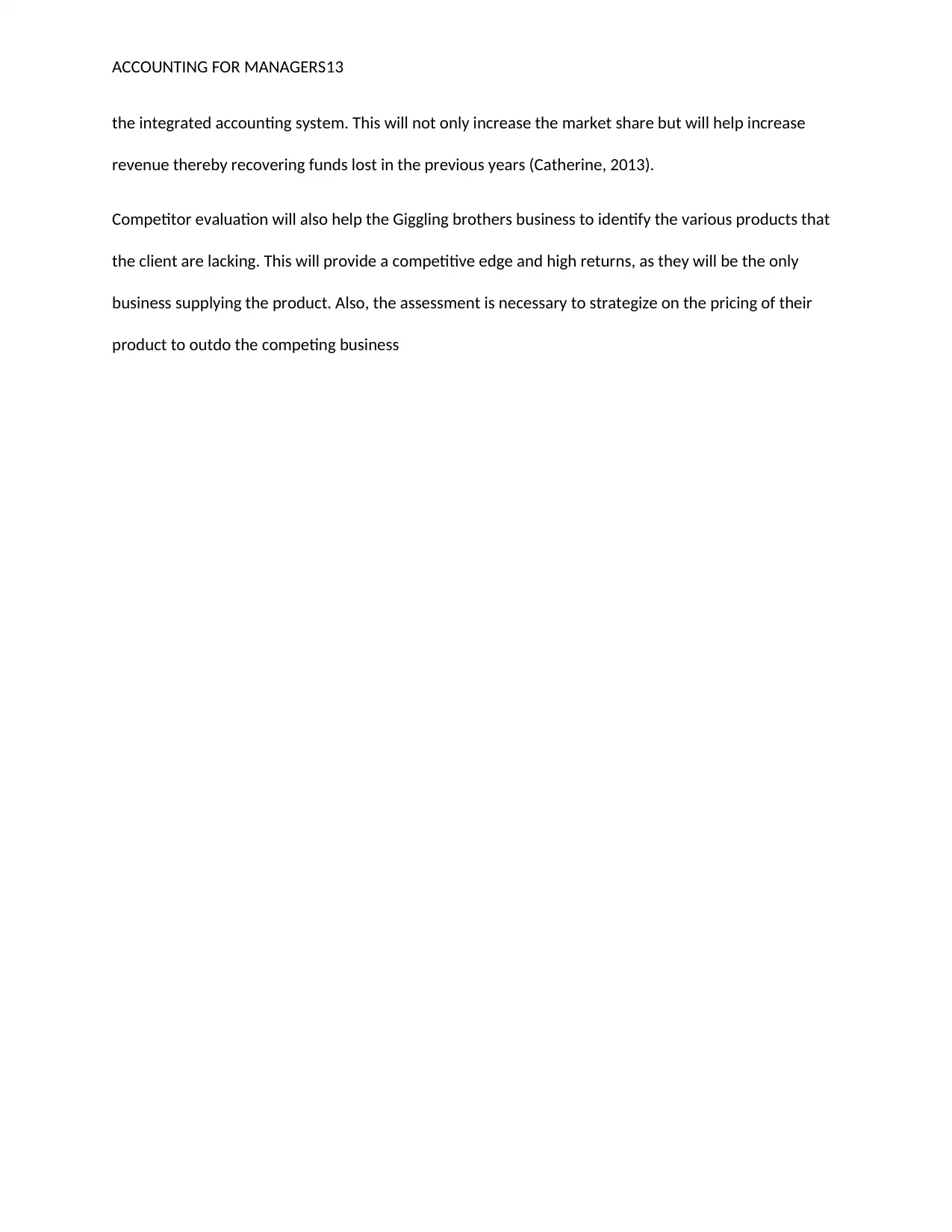
ACCOUNTING FOR MANAGERS13
the integrated accounting system. This will not only increase the market share but will help increase
revenue thereby recovering funds lost in the previous years (Catherine, 2013).
Competitor evaluation will also help the Giggling brothers business to identify the various products that
the client are lacking. This will provide a competitive edge and high returns, as they will be the only
business supplying the product. Also, the assessment is necessary to strategize on the pricing of their
product to outdo the competing business
the integrated accounting system. This will not only increase the market share but will help increase
revenue thereby recovering funds lost in the previous years (Catherine, 2013).
Competitor evaluation will also help the Giggling brothers business to identify the various products that
the client are lacking. This will provide a competitive edge and high returns, as they will be the only
business supplying the product. Also, the assessment is necessary to strategize on the pricing of their
product to outdo the competing business
Paraphrase This Document
Need a fresh take? Get an instant paraphrase of this document with our AI Paraphraser
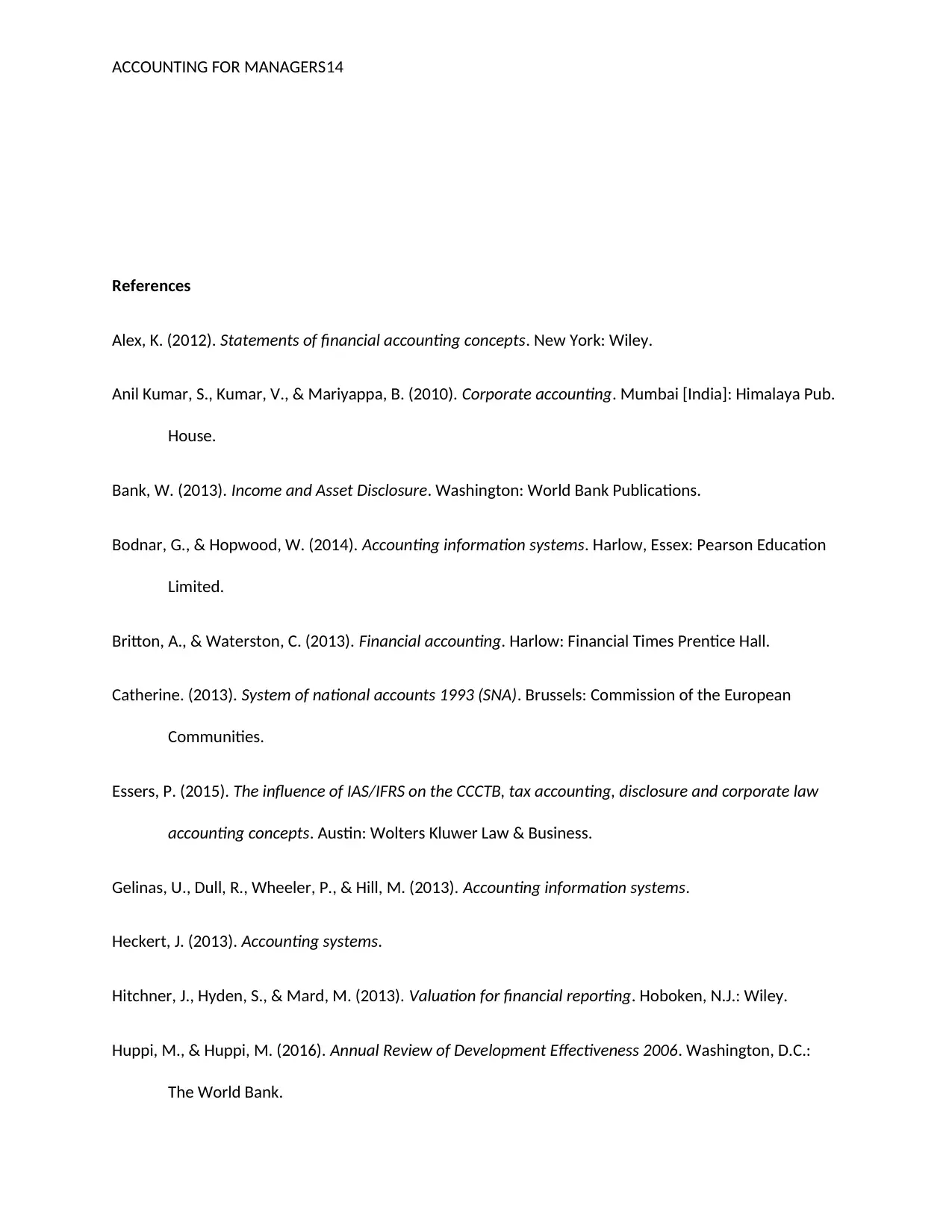
ACCOUNTING FOR MANAGERS14
References
Alex, K. (2012). Statements of financial accounting concepts. New York: Wiley.
Anil Kumar, S., Kumar, V., & Mariyappa, B. (2010). Corporate accounting. Mumbai [India]: Himalaya Pub.
House.
Bank, W. (2013). Income and Asset Disclosure. Washington: World Bank Publications.
Bodnar, G., & Hopwood, W. (2014). Accounting information systems. Harlow, Essex: Pearson Education
Limited.
Britton, A., & Waterston, C. (2013). Financial accounting. Harlow: Financial Times Prentice Hall.
Catherine. (2013). System of national accounts 1993 (SNA). Brussels: Commission of the European
Communities.
Essers, P. (2015). The influence of IAS/IFRS on the CCCTB, tax accounting, disclosure and corporate law
accounting concepts. Austin: Wolters Kluwer Law & Business.
Gelinas, U., Dull, R., Wheeler, P., & Hill, M. (2013). Accounting information systems.
Heckert, J. (2013). Accounting systems.
Hitchner, J., Hyden, S., & Mard, M. (2013). Valuation for financial reporting. Hoboken, N.J.: Wiley.
Huppi, M., & Huppi, M. (2016). Annual Review of Development Effectiveness 2006. Washington, D.C.:
The World Bank.
References
Alex, K. (2012). Statements of financial accounting concepts. New York: Wiley.
Anil Kumar, S., Kumar, V., & Mariyappa, B. (2010). Corporate accounting. Mumbai [India]: Himalaya Pub.
House.
Bank, W. (2013). Income and Asset Disclosure. Washington: World Bank Publications.
Bodnar, G., & Hopwood, W. (2014). Accounting information systems. Harlow, Essex: Pearson Education
Limited.
Britton, A., & Waterston, C. (2013). Financial accounting. Harlow: Financial Times Prentice Hall.
Catherine. (2013). System of national accounts 1993 (SNA). Brussels: Commission of the European
Communities.
Essers, P. (2015). The influence of IAS/IFRS on the CCCTB, tax accounting, disclosure and corporate law
accounting concepts. Austin: Wolters Kluwer Law & Business.
Gelinas, U., Dull, R., Wheeler, P., & Hill, M. (2013). Accounting information systems.
Heckert, J. (2013). Accounting systems.
Hitchner, J., Hyden, S., & Mard, M. (2013). Valuation for financial reporting. Hoboken, N.J.: Wiley.
Huppi, M., & Huppi, M. (2016). Annual Review of Development Effectiveness 2006. Washington, D.C.:
The World Bank.
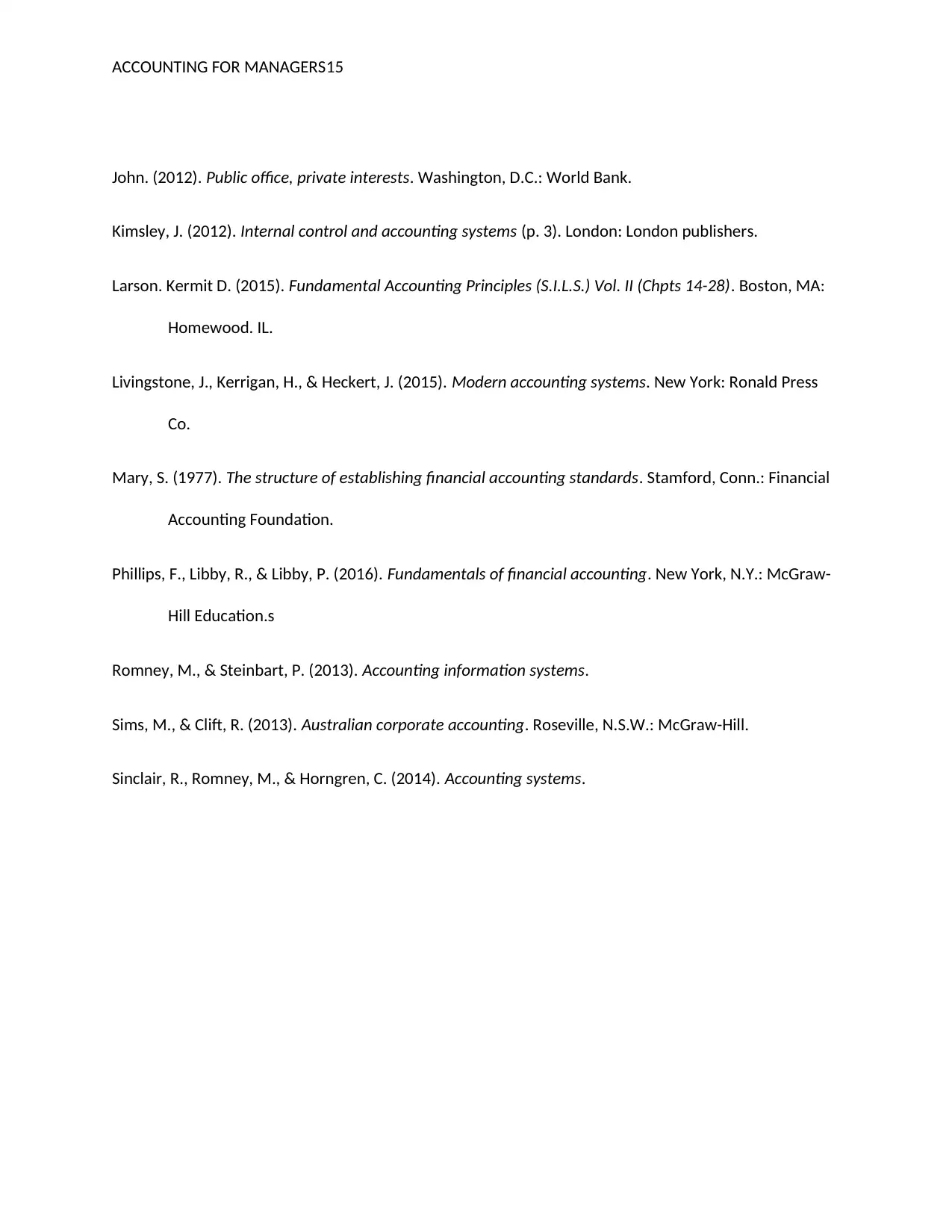
ACCOUNTING FOR MANAGERS15
John. (2012). Public office, private interests. Washington, D.C.: World Bank.
Kimsley, J. (2012). Internal control and accounting systems (p. 3). London: London publishers.
Larson. Kermit D. (2015). Fundamental Accounting Principles (S.I.L.S.) Vol. II (Chpts 14-28). Boston, MA:
Homewood. IL.
Livingstone, J., Kerrigan, H., & Heckert, J. (2015). Modern accounting systems. New York: Ronald Press
Co.
Mary, S. (1977). The structure of establishing financial accounting standards. Stamford, Conn.: Financial
Accounting Foundation.
Phillips, F., Libby, R., & Libby, P. (2016). Fundamentals of financial accounting. New York, N.Y.: McGraw-
Hill Education.s
Romney, M., & Steinbart, P. (2013). Accounting information systems.
Sims, M., & Clift, R. (2013). Australian corporate accounting. Roseville, N.S.W.: McGraw-Hill.
Sinclair, R., Romney, M., & Horngren, C. (2014). Accounting systems.
John. (2012). Public office, private interests. Washington, D.C.: World Bank.
Kimsley, J. (2012). Internal control and accounting systems (p. 3). London: London publishers.
Larson. Kermit D. (2015). Fundamental Accounting Principles (S.I.L.S.) Vol. II (Chpts 14-28). Boston, MA:
Homewood. IL.
Livingstone, J., Kerrigan, H., & Heckert, J. (2015). Modern accounting systems. New York: Ronald Press
Co.
Mary, S. (1977). The structure of establishing financial accounting standards. Stamford, Conn.: Financial
Accounting Foundation.
Phillips, F., Libby, R., & Libby, P. (2016). Fundamentals of financial accounting. New York, N.Y.: McGraw-
Hill Education.s
Romney, M., & Steinbart, P. (2013). Accounting information systems.
Sims, M., & Clift, R. (2013). Australian corporate accounting. Roseville, N.S.W.: McGraw-Hill.
Sinclair, R., Romney, M., & Horngren, C. (2014). Accounting systems.
You're viewing a preview
Unlock full access by subscribing today!
1 out of 15
Related Documents
Your All-in-One AI-Powered Toolkit for Academic Success.
+13062052269
info@desklib.com
Available 24*7 on WhatsApp / Email
![[object Object]](/_next/static/media/star-bottom.7253800d.svg)
Unlock your academic potential
© 2024 | Zucol Services PVT LTD | All rights reserved.





